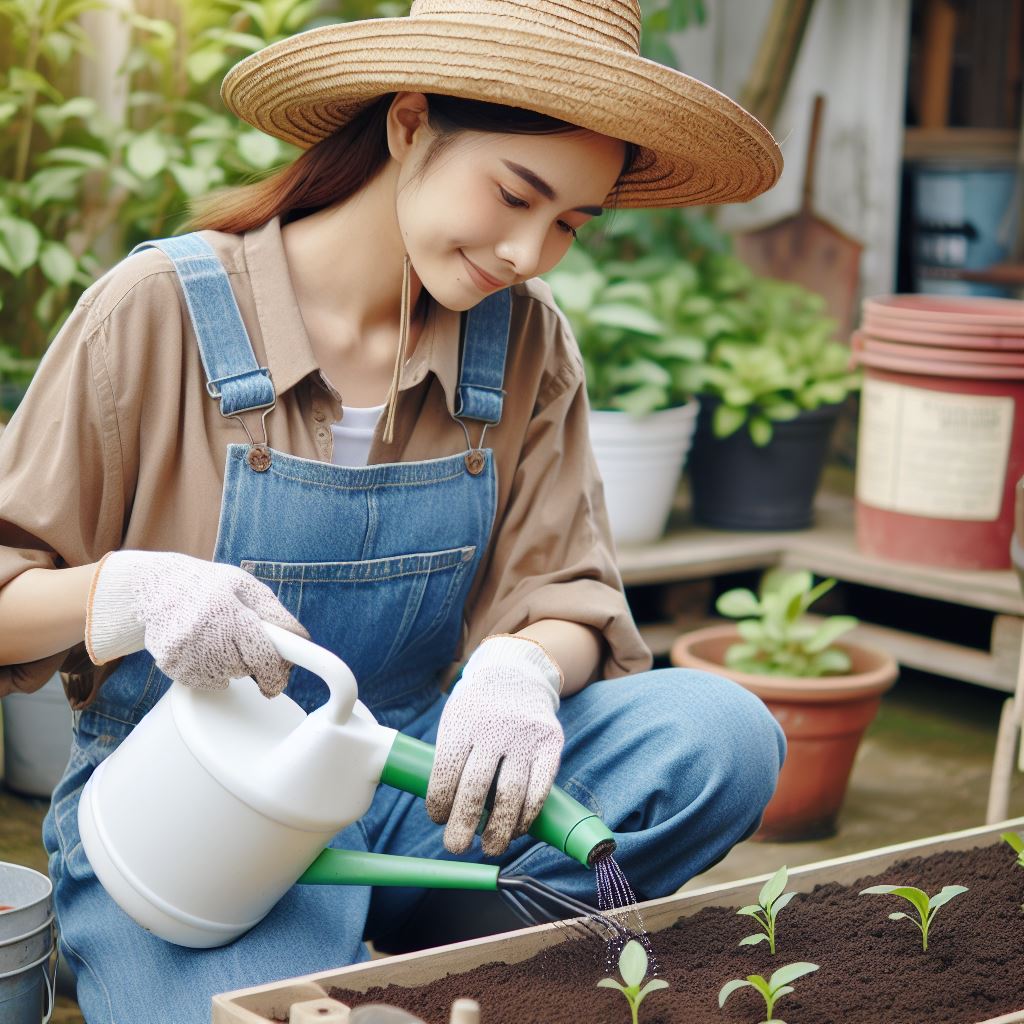Introduction
Pest control plays a critical role in crop management as it ensures healthy and abundant harvests.
Importance of effective pest control in crop management
Effective pest control is essential to protect crops from pests and diseases.
Impact of pests on crop yield and quality
Pests can cause significant damage to crop yield and quality, resulting in financial losses for farmers. Not only do pests reduce crop productivity, but they can also lower the quality of harvested produce.
This can lead to market rejection and decreased profitability for farmers. In order to maximize crop yield and quality, it is imperative to implement effective pest control measures.
Such measures can include biological control, cultural practices, and the use of chemical pesticides. Biological control involves using beneficial insects or organisms to control pests naturally.
Cultural practices, like crop rotation and sanitation, can also help minimize pest populations. Chemical pesticides can be used as a last resort, but their usage should be judicious to minimize environmental impact.
By employing a comprehensive pest control strategy, farmers can protect their crops and optimize their harvests. This not only ensures food security but also contributes to sustainable agricultural practices.
Basically, effective pest control is of utmost importance in crop management to protect yield and quality.
Understanding Pest Control
Pest control in crop management refers to the methods and techniques used to manage and control pests that can damage crops.
It involves the prevention, detection, and eradication of pests to minimize crop yield losses.
Pests can include insects, weeds, fungi, bacteria, viruses, rodents, and other animals.
These pests can cause significant damage to crops, leading to reduced yield, quality, and market value.
Integrated Pest Management (IPM) is a holistic approach to crop protection that aims to reduce pesticide use.
Definition of Pest Control in Crop Management
Pest control in crop management involves the management and control of pests that adversely affect agricultural crops.
It encompasses various strategies and practices to prevent, suppress, or eradicate pests.
The goal is to maintain crop health and productivity while minimizing the negative impacts of pests on the environment and human health.
Transform Your Agribusiness
Unlock your farm's potential with expert advice tailored to your needs. Get actionable steps that drive real results.
Get StartedDifferent Types of Pests Commonly Found in Agriculture
- Insects: These pests include aphids, beetles, caterpillars, and weevils, which feed on crops and transmit diseases.
- Weeds: Unwanted plants that compete with crops for nutrients, water, and sunlight, reducing crop yield.
- Fungi: Pathogenic fungi cause diseases such as powdery mildew, rust, and blights, affecting crop quality and yield.
- Bacteria and Viruses: These microorganisms infect crops, causing diseases that can lead to significant losses.
- Rodents and Other Animals: Rats, mice, birds, and other animals can damage crops by feeding on them or contaminating them.
The Role of Integrated Pest Management (IPM) in Crop Protection
IPM is an approach that combines biological, cultural, physical, and chemical methods to control pests. It aims to suppress pests below economically damaging levels while minimizing risks to human health and the environment.
- Biological Control: The use of natural enemies such as predators, parasitoids, and pathogens to control pests.
- Cultural Practices: Crop rotation, proper irrigation and fertilization, and habitat manipulation to disrupt pest life cycles.
- Physical Methods: Mechanical barriers, traps, and physical removal of pests to prevent their access to crops.
- Chemical Control: The judicious use of pesticides when necessary, considering their efficacy, target specificity, and environmental impact.
- Monitoring and Decision-Making: Regular pest monitoring to assess pest populations and determine appropriate control measures.
- Economic Considerations: Evaluating the economic thresholds for pest damage and the cost-effectiveness of control measures.
Benefits of Effective Pest Control in Crop Management
- Increased Crop Yields: By effectively managing pests, crop yields can be maximized, ensuring a stable food supply.
- Improved Crop Quality: Controlling pests helps maintain the quality and market value of agricultural products.
- Reduced Pesticide Use: IPM strategies reduce reliance on chemical pesticides, minimizing negative environmental impacts.
- Preservation of Beneficial Organisms: IPM promotes the conservation of natural enemies, pollinators, and beneficial organisms.
- Enhanced Farm Sustainability: Effective pest control contributes to the long-term sustainability of agricultural systems.
In short, understanding pest control in crop management is crucial for maintaining crop health and productivity. Different types of pests can cause significant damage to crops, which can be managed through integrated pest management practices.
By adopting IPM strategies, farmers can effectively control pests while minimizing the use of chemical pesticides, promoting sustainable agriculture.
Achieving effective pest control leads to increased crop yields, improved crop quality, and the preservation of beneficial organisms in the agricultural ecosystem.
Read: Tech in Pest Control: Efficient Crop Protection
Identifying Common Crop Pests
Pests can wreak havoc on crops and cause significant damage if not properly managed. Effective pest control in crop management starts with identifying the common pests that can infest crops.
Description of common pests and their characteristics (insects, rodents, weeds, etc.)
Here are descriptions of some common pests and their characteristics.
- Insects: Insects are one of the most common types of pests that attack crops. They include aphids, beetles, caterpillars, and grasshoppers. Each insect has unique characteristics that distinguish them from one another.
- Aphids: Aphids are small insects that feed on the sap of plants. They reproduce quickly and can cause stunted growth and yellowing of leaves.
- Beetles: Beetles, such as the Colorado potato beetle, can defoliate crops, especially potato plants. They have hard outer shells and can be challenging to control.
- Caterpillars: Caterpillars, like the notorious corn earworm, munch on leaves and crops, causing severe damage. They have segmented bodies and are often found curled up on plants.
- Grasshoppers: Grasshoppers are voracious feeders and can consume large amounts of crop foliage. They have long hind legs for jumping and can be identified by their distinct sound.
- Rodents: Rodents, including rats and mice, can also pose a threat to crops. They can dig tunnels and feed on various plant parts, leading to reduced yields.
- Weeds: While not traditionally considered pests, weeds compete with crops for nutrients, water, and light. Common weeds include pigweeds, kochia, and foxtails.
Signs of Pest Presence in Crops
Detecting the signs of pest presence in crops is essential for early intervention and effective pest control. Here are some signs to look out for:
- Chewed leaves: If you notice leaves with irregular holes or missing sections, it may indicate the presence of insects or caterpillars.
- Sticky residue: A sticky residue on leaves, known as honeydew, can be a sign of aphid infestation. It is caused by their feeding activities.
- Yellowing or wilting: Yellowing or wilting of leaves can be an indicator of various pests, such as nematodes or root-feeding insects.
- Damaged fruit or seeds: Pests like beetles or rodents may leave behind partially eaten or damaged fruit and seeds.
Monitoring Techniques for Early Detection
Early detection of pests is crucial for effective pest control in crop management. Here are some monitoring techniques that can help detect pest infestations early:
- Visual inspections: Regularly inspect crops, focusing on the undersides of leaves, stems, and developing fruits for signs of pests.
- Sticky traps: Place sticky traps at different locations within the crop field to capture flying insects like aphids and thrips.
- Pheromone traps: Pheromone traps lure specific pests like moths or beetles with their synthetic sex hormones, aiding in monitoring and population control.
- Crop scouting: Systematically walk through the fields, observing and documenting the presence of pests and their damage.
By identifying common crop pests, recognizing the signs of their presence, and implementing monitoring techniques, farmers can take proactive measures to control pests effectively.
This promotes crop health and ensures higher yields, contributing to sustainable agriculture practices.
Read: Modern Farm Equipment: Changing Ag Landscape
Preventive Measures for Pest Control
- Implement Cultural Practices: Incorporate crop rotation, proper irrigation, and other practices to reduce pest infestation.
- Use Physical Barriers and Traps: Install barriers such as nets, fences, or screens to prevent pests from entering the crops. Set up traps to catch and control pests.
- Follow Good Agricultural Practices (GAPs): Adhere to GAPs to minimize pest damage and maintain healthy crop growth.
- Monitor and Identify Pests: Regularly inspect crops for signs of pest presence, and identify the specific pests causing damage.
- Introduce Beneficial Insects: Release beneficial organisms like ladybugs or parasitic wasps that prey on pests to naturally control their population.
- Implement Sanitation Measures: Maintain cleanliness in and around the fields, removing any potential habitats or food sources for pests.
- Practice Timely Harvesting: Harvest crops at the right stage of maturity to prevent overripe produce, which may attract pests.
- Optimize Plant Nutrition: Ensure crops receive adequate nutrients and have optimal growing conditions to promote their resilience against pests.
- Utilize Biopesticides: Substituting synthetic pesticides with environmentally friendly biopesticides can help control pests without harming beneficial organisms.
- Employ Integrated Pest Management (IPM) Strategies: Use a combination of preventive measures, monitoring, natural enemies, and targeted pesticide use.
Cultural Practices to Reduce Pest Infestation
- Crop rotation: Crop rotation involves planting different crops in a specific sequence within a particular area. It helps disrupt the pest’s life cycle and reduces the occurrence of pests that specialize in specific crops.
- Proper irrigation: Applying the right amount of water at the right time is crucial for healthy crop growth. Over-irrigation can lead to waterlogging, creating a favorable environment for pests like root rot pathogens.
- Soil fertility management: Maintaining proper soil fertility is essential as nutrient-deficient plants become more susceptible to pest attacks. Regularly test soil quality and provide necessary nutrients to optimize crop health.
- Weed management: Uncontrolled weed growth can provide shelter and food for pests. Effective weed management practices, such as mulching or mechanical cultivation, can reduce pest infestation.
- Crop residue management: Promptly removing crop residues can prevent the buildup of pests and diseases. Proper disposal or incorporation of crop residues helps break the pest’s life cycle.
Use of Physical Barriers and Traps
- Physical barriers: Installing physical barriers like nets, fences, or screens can prevent pests from directly accessing crop fields. These barriers create a protective barrier while allowing air and sunlight to reach the plants.
- Traps: Strategically placing traps, such as sticky traps or pheromone traps, can help monitor and control pest populations. Traps attract pests and capture them, reducing their numbers without resorting to chemicals.
- Mass trapping: Mass trapping involves using highly attractive lures and traps to capture a large number of pests. This method disrupts the pest’s mating cycle, significantly reducing their population.
- Using pheromones: Pheromones are chemicals released by pests to communicate with mates or identify suitable feeding grounds. Synthetic pheromones can be used to confuse pests, disrupt their behavior, and prevent mating.
Implementing Good Agricultural Practices (GAPs) to Minimize Pest Damage
- Field hygiene: Maintaining clean and tidy fields minimizes hiding spots and food sources for pests. Regularly remove crop debris, fallen fruits, and weeds to reduce pest infestation.
- Mulching: Applying organic mulch around plants can deter pests, maintain soil moisture, and improve overall plant health. Mulch acts as a physical barrier, preventing pests from reaching the plants.
- Proper waste management: Dispose of agricultural waste responsibly to prevent pest outbreaks and the spread of diseases. Compost or safely burn waste materials to reduce the presence of pests.
- Prophylactic treatment: Applying preventative treatments, such as biopesticides or plant strengtheners, before pests appear can enhance plant defenses and reduce susceptibility to pest attacks.
- Proper storage: Store harvested crops properly in clean and ventilated storage areas to prevent infestations by rodents or insects. Regularly inspect and clean storage facilities.
By incorporating these preventive measures, cultural practices, physical barriers, and implementing good agricultural practices (GAPs), farmers can effectively control pests, minimize crop damage, and ensure sustainable crop management.
Read: Innovations in Soil Health: Tech’s Role

Biological Pest Control: Harnessing the Power of Nature
Introduction to Biological Pest Control
Biological control methods have emerged as a sustainable and environmentally friendly solution to pest management in crop production.
Instead of relying on chemical pesticides that can be harmful to both humans and the ecosystem, this approach utilizes natural enemies to control pest populations. By harnessing the power of nature itself, farmers can effectively manage pests while preserving biodiversity.
Benefits of Using Natural Enemies
- Natural enemies, such as predators and parasitoids, play a vital role in reducing pest populations. These organisms feed on pests, effectively controlling their numbers and minimizing crop damage.
- Unlike chemical pesticides, natural enemies are specific in their actions. They target only the pests, leaving beneficial insects unharmed. This targeted approach ensures a balanced ecosystem and reduces the risk of resistance development.
- Natural enemies are self-sustaining. Once introduced into the environment, they reproduce and continue to control pests without the need for constant intervention. This saves farmers time and money in the long run.
- Using natural enemies in pest control reduces the usage of chemical pesticides, leading to a decrease in chemical residues on crops. This benefits both consumer health and the environment.
Promoting Biodiversity to Enhance Natural Pest Control
- Biodiversity plays a crucial role in enhancing natural pest control. By creating a diverse and healthy ecosystem, farmers can attract and support a wide range of natural enemies.
- Planting a variety of crops and wildflowers provides habitat and food sources for natural enemies. This increases their population and activities, thus leading to enhanced pest control.
- Structural diversity, such as hedgerows and insectary plants, offers shelter and nectar to natural enemies. This further promotes their presence in agricultural landscapes.
- Limiting the use of broad-spectrum insecticides, which can harm natural enemies, is crucial for maintaining biodiversity. Farmers should adopt integrated pest management strategies that prioritize biological control methods.
- Conservation strategies, such as protecting natural habitats and promoting native vegetation, contribute to the long-term sustainability of natural pest control. These efforts help maintain the presence of natural enemies in the agricultural landscape.
- Collaboration between farmers, researchers, and policymakers is essential in promoting biodiversity and natural pest control. Governments should provide incentives for farmers to adopt sustainable practices and invest in research on biological control methods.
Generally, biological pest control offers a sustainable alternative to chemical pesticides, with numerous benefits for both farmers and the environment.
By harnessing natural enemies and promoting biodiversity, we can effectively manage pests while preserving the delicate balance of ecosystems. Embracing this approach will contribute to a healthier, more resilient agricultural system for future generations.
Read: AI & Robotics: Revolutionizing Crop Management
Chemical Pest Control
Overview of Chemical Pesticides
Chemical pesticides are substances used to control pests in crop management.
They can be classified into different types based on their mode of action.
Examples include insecticides, herbicides, fungicides, and rodenticides.
Safety Considerations and Proper Handling
It is essential to follow safety guidelines when using chemical pesticides.
Read and understand the label instructions before applying any pesticide.
Showcase Your Farming Business
Publish your professional farming services profile on our blog for a one-time fee of $200 and reach a dedicated audience of farmers and agribusiness owners.
Publish Your ProfileUse appropriate protective equipment such as gloves, goggles, and respirators.
Store pesticides in a secure area away from children, pets, and food products.
Dispose of pesticide containers properly and avoid reusing them for other purposes.
Be aware of the potential hazards by understanding the toxicity and persistence of the pesticides.
Follow the recommended dosage and avoid exceeding the specified application rate.
Consult trained professionals or pesticide specialists for proper handling techniques.
Regularly check and maintain spraying equipment to ensure proper functioning.
Keep a record of pesticide applications, including dates, quantities, and target pests.
Integrated Use of Chemical Pesticides in IPM Strategies
Integrated Pest Management (IPM) aims to minimize pesticide use while effectively controlling pests.
Chemical pesticides are one of the components in an integrated approach to pest management.
IPM strategies involve monitoring and assessing pest populations before applying pesticides.
Determine the economic threshold level to avoid unnecessary pesticide applications.
Use insect traps, visual inspections, and other monitoring techniques to identify pest presence.
Consider cultural practices like crop rotation and maintaining optimal plant health to reduce pest pressure.
Biological control methods such as introducing natural predators or using microbial agents can complement chemical pesticides.
Timing is crucial when applying chemical pesticides to maximize their effectiveness.
Avoid spraying during peak pollination or when beneficial insects are present.
Rotate pesticide classes to minimize the risk of developing resistance in pest populations.
Educate farmers about sustainable pest control practices and the proper use of chemical pesticides.
Develop integrated pest management plans tailored to specific crop and pest combinations.
In general, chemical pest control plays a significant role in crop management when used appropriately. It is vital to have a good understanding of different chemical pesticides and their proper handling techniques.
Safety considerations should be a priority to protect human health, the environment, and non-target organisms.
Integrated pest management strategies offer a holistic approach to pest control, combining chemical pesticides with other methods to minimize their usage.
Farmers and agricultural professionals should strive towards sustainable pest management practices to ensure long-term crop health and productivity.
Delve into the Subject: Understanding N-P-K Ratios in Fertilizers
Sustainable Pest Control
Pest control in crop management is crucial for ensuring sustainable agriculture practices. By effectively managing pests, farmers can protect their crops, increase yields, and minimize the use of harmful chemicals.
Sustainable pest control practices play a vital role in achieving these goals.
Importance of sustainable pest control practices
There are several reasons why sustainable pest control practices are important. Firstly, they help maintain a balanced ecosystem in agricultural fields.
Pests and beneficial organisms exist in a delicate balance, and using harmful chemicals can disrupt this balance, leading to unintended consequences.
Sustainable pest control practices, on the other hand, aim to minimize the negative impact on beneficial organisms while targeting pests effectively.
Use of organic and biopesticides
Organic and biopesticides are essential components of sustainable pest control. These substances are derived from natural sources such as plants, bacteria, and minerals.
Unlike conventional pesticides, organic and biopesticides have fewer adverse effects on human health and the environment. They are less persistent in the environment, reducing the risk of contamination in soil and water.
Implementation of eco-friendly pest control alternatives
Implementing eco-friendly pest control alternatives is another crucial aspect of sustainable pest management. These alternatives strive to reduce the reliance on chemical pesticides by employing various methods.
One such method is the use of integrated pest management (IPM) techniques. IPM involves a combination of cultural, biological, and chemical control measures tailored to specific pest problems.
It focuses on preventing pests through practices such as crop rotation, proper irrigation, and maintaining healthy soil.
Crop diversification is also an effective strategy in sustainable pest control. By growing a variety of crops, farmers can reduce pest pressures as different pests target different crops.
Additionally, intercropping, where two or more crop species are grown together, can disrupt pest life cycles and reduce pest populations naturally. This approach minimizes the need for chemical interventions.
The use of traps, pheromones, and beneficial insects is another eco-friendly method of pest control. Traps attract and capture pests, preventing them from infesting crops.
Pheromones, which are chemicals emitted by pests to communicate, can be used to disrupt their mating patterns, preventing population growth.
Furthermore, beneficial insects such as ladybirds and lacewings can be introduced into agricultural fields to prey on pests, reducing their numbers.
Showcase Your Farming Business
Publish your professional farming services profile on our blog for a one-time fee of $200 and reach a dedicated audience of farmers and agribusiness owners.
Publish Your ProfileSustainable pest control practices also require continuous monitoring and regular scouting of fields. By regularly inspecting crops, farmers can identify pest outbreaks or signs of infestation.
This enables timely intervention, reducing the need for extensive pesticide application. Monitoring can be done manually or through the use of modern technologies such as drones equipped with sensors that can detect pest hotspots.
In the end, sustainable pest control practices are essential for effective crop management.
By utilizing organic and biopesticides, implementing eco-friendly alternatives, and employing various pest control methods, farmers can protect their crops while minimizing the use of harmful chemicals.
Sustainable pest control not only benefits agricultural productivity but also contributes to the preservation of our ecosystem. With the increasing focus on sustainable agriculture, adopting these practices is crucial for the future of crop management.
Monitoring and Evaluation of Pest Control
Regular pest monitoring and assessment allow for early detection of pest infestations.
Record-keeping is essential for tracking pest populations and evaluating responses to control methods.
By analyzing monitoring results, strategies can be adjusted to achieve effective pest control.
Pest control is a crucial aspect of crop management that ensures the protection and productivity of agricultural crops. Effective pest control involves monitoring and evaluation, regular assessment, record-keeping, and adjusting strategies based on monitoring results.
Regular Pest Monitoring and Assessment
Regular and consistent pest monitoring is essential in preventing extensive damage caused by pest infestations.
By implementing monitoring protocols, farmers can detect the presence of pests at an early stage, allowing for timely intervention and minimizing crop losses.
Monitoring involves observing and documenting pest populations, their behavior, and the extent of damage inflicted on crops.
An integral part of regular pest monitoring is the assessment of the severity and spread of pest infestations. This helps farmers determine the appropriate control measures needed to combat pests effectively.
Through assessment, the identification of pest hotspots and vulnerable areas becomes possible, allowing for targeted control efforts.
Record-keeping for Tracking Pest Populations and Responses
Record-keeping plays a vital role in pest control as it allows farmers to track the population trends of pests and assess the effectiveness of control methods used.
By maintaining accurate records, farmers can monitor the changes in pest populations over time and identify any patterns or trends that require attention.
Additionally, record-keeping facilitates the evaluation of responses to control methods. Farmers can compare different control strategies and identify which ones are most effective in controlling specific pest species.
This information enables them to make informed decisions and select the most appropriate control measures for their particular crop and pest situation.
Adjusting Strategies Based on Monitoring Results
The monitoring and evaluation of pest control efforts provide valuable insights that enable farmers to adjust their strategies accordingly.
By analyzing monitoring data, farmers can identify any gaps or shortcomings in their current control methods and make necessary adaptations.
Monitoring results can reveal the presence of new pest species or the development of resistance to certain control measures.
This information allows farmers to revise their strategies and explore alternative control methods to prevent or manage such challenges effectively. Implementing proactive adjustments based on monitoring results ensures ongoing pest control effectiveness.
Overall, effective pest control in crop management relies on monitoring and evaluation. Regular pest monitoring and assessment, combined with record-keeping, enable farmers to track pest populations, evaluate control methods, and make data-driven decisions.
Adjusting strategies based on monitoring results ensures continuous improvement in pest control and safeguards agricultural crops.
Conclusion
Recap of the importance of effective pest control in crop management
All in all, effective pest control plays a crucial role in crop management. It ensures the health and productivity of crops, leading to higher yields and profitability for farmers.
The importance of pest control cannot be understated, as pests can cause significant damage and loss if left unchecked.
Emphasis on the need for a holistic approach to pest control
To achieve effective pest control, a holistic approach is necessary. This involves considering various factors such as crop rotation, biological control methods, and the judicious use of pesticides.
Implementing integrated pest management (IPM) strategies can help reduce reliance on chemical treatments and promote sustainable farming practices.
Encouraging continuous learning and improvement in pest control practices.
Continuous learning and improvement in pest control practices are essential. New pests and diseases can emerge, and existing ones may develop resistance to conventional control methods.
Farmers should stay updated on the latest research and techniques, attending workshops and training programs to enhance their knowledge.
Collaboration and knowledge sharing among farmers, researchers, and agricultural professionals are vital for successful pest control. By learning from one another’s experiences and sharing best practices, the farming community can collectively improve pest control methods.
Ultimately, effective pest control is crucial for maintaining crop health and maximizing yields.
Adopting a holistic approach, staying informed about advancements, and continuously improving pest control practices are key to overcoming the challenges posed by pests and ensuring sustainable crop management.




